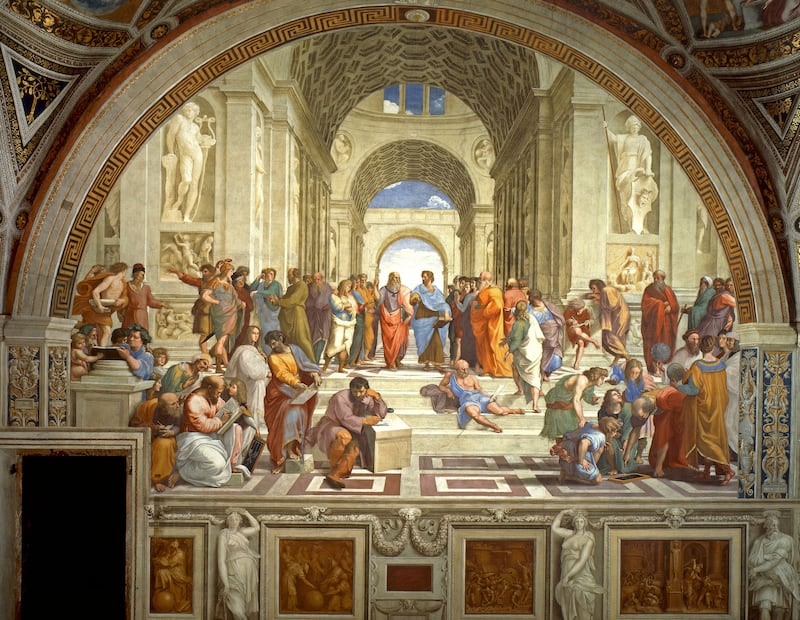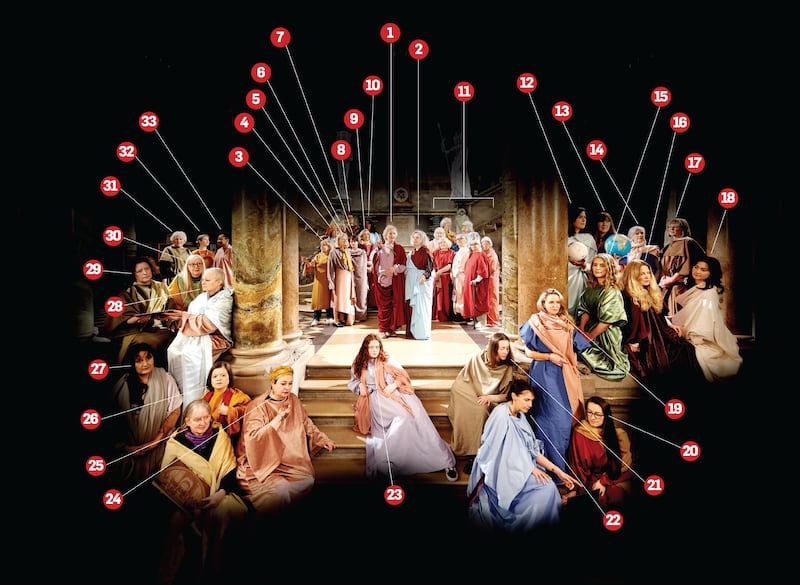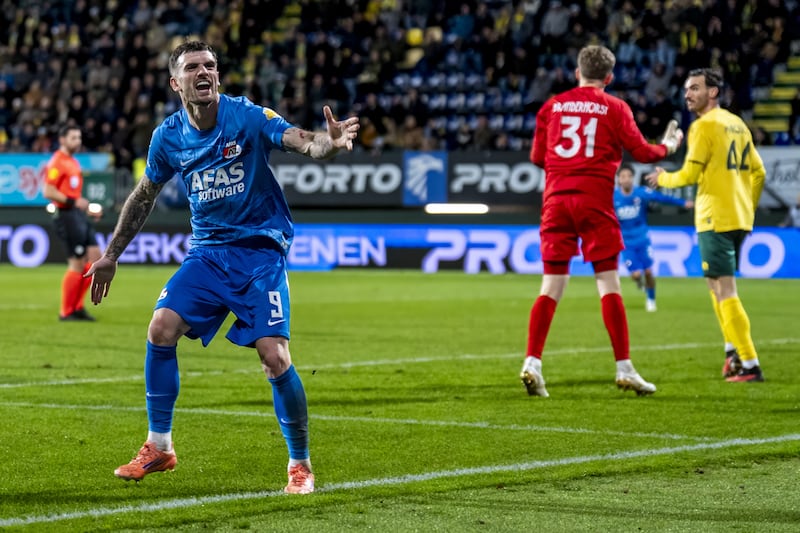“If a female had once passed the gate… it would be practically impossible to watch what buildings or what chambers she might enter, or how long she might remain there.” So wrote the board of Trinity College Dublin in 1895, on high alert to the danger of admitting women students. On a wet Saturday morning well over a century later, dozens of women dressed in togas congregate in the foyer of the university’s museum building. They are here for an all-woman restaging of The School of Athens, Raphael’s 16th-century fresco.
Raphael’s Vatican original depicts 50 male philosophers, mathematicians and scientists. Participants in the School of Hibernia project, which has been devised by the art collective Na Cailleacha, are women of all ages and backgrounds, whose fields include social justice, sport, climate change, disability rights, politics, genetics, law and the arts. Photographed by Ros Kavanagh and staged in collaboration with Trinity’s history of art and architecture department with the theatre director Medb Lambert and the choreographer Cindy Cummings, The School of Hibernia showcases achievement, solidarity and perseverance, as some of the participants explain.

Linda Doyle
First woman provost of Trinity College Dublin
“This ‘performance’ was a wonderful way to have a conversation about the representation and inclusion of women in the visual landscape, without in fact having to say anything – though there was much conversation to be had around the fringes of the event. There was something very vibrant and dynamic about a group of women coming together and occupying the space the way we did. I loved the scale of the project, and ambition of the project, yet it all came together with what seemed like complete ease, as if it were meant to be. Having said that, we do live a world in which these kinds of interventions are still needed. The inclusion of the first women sculptures in the Long Room of the Old Library at Trinity College on St Brigid’s Day 2023 needed an intentional act – it was not something that simply evolved.”
Catherine Marshall
Art collective Na Cailleacha
“As an art historian teaching in Trinity in the past, I was very conscious that the role models we offered to students generally presented women – if at all – as reclining nudes or sacrificial virgins. I thought we could have fun with the canon of art history by turning one of the landmark images on its head, filling it with women. But then the idea grew into the living women we want to celebrate, and since the original painting was about education we asked ourselves how women had changed attitudes to learning and knowledge and therefore to how we live. This is a really good story about Irish women and should be told beyond these shores.”
READ MORE
[ Raphael: A celebration of his life and work, on his 500th anniversaryOpens in new window ]
Rita Fagan
Community housing activist
“Women of my class have been invisible unless they write themselves in. I liked the idea of clearing the canvas and filling it with women of substance. Women with lived experience. Who used their voice and bold courage to speak out or break the glass ceiling. Women who were not afraid to challenge power structures. Let us see if this art creation will stun the institutions and inspire them to have the courage to transform their terrain. At least sharing the walls with their equals.”
Susan McKay
Press Ombudsman and writer
“‘Ireland is changing, Mother,’ wrote the poet Rita Ann Higgins. And so it is. It was delightful to be in the company of all these magnificent women who, through their ideas, leadership, achievements, imagination, canny wisdom and sheer persistence are changing Ireland day by day. It was exhilarating to look at women, many of whom have had to battle every inch of the way to get to where they are now, and know that they have cleared paths for others to follow, and that many, many other women could equally have been chosen for the tableau. That was the celebratory side. On the other hand, manels” – all-male panels – “sadly, are still with us, and the replacement of all those ancient men by all of us modern women made a still subversive point. I love politically engaged art, and the creative team behind this were fantastic, as well as being able to manage a crowd of very stroppy, rowdy and excited women.”
Mary E Daly
First woman president of the Royal Irish Academy
“I have often found that many professional women that I have met were, like me, rushing because of multiple commitments, so our conversations and interactions were often curtailed. When we manage to get together, conversations are generally lively and diverse. While you can argue that the women present have challenged patriarchy in Irish society, I, and I suspect some others present, have done this in a pragmatic manner – mainly by achievement as opposed to rhetoric. Some were campaigners, others, including myself, focused on demonstrating what women can do in their professional career, and both approaches are valid.”
Sarah McCormack
Professor of sustainable energy at Trinity College Dublin
“Opportunities for women from such a broad spectrum of disciplines to come together are unfortunately rare, making this project even more significant. This project broke down those barriers, fostering a unique interdisciplinary dialogue that highlighted the interconnectedness of our struggles and triumphs as women.”
Philippa Ryder
LGBTQ+ activist, feminist and chair of Dublin Pride
“It was amazing to be with such accomplished and inspiring women. The energy and knowledge in the room were palpable, every conversation – of which there were many – brought new ideas and new experiences. The multiple opportunities to chat, especially over lunch, led to lots of new connections, and friendships.”
Melatu Uche Okorie
Writer and member of the Arts Council
“It provided a wonderful opportunity to connect with people that I haven’t seen in a long time, and to meet new people. I guess we can argue this point, in that people meet all the time – on the road, coffee shops, shops, at school gates for pick-ups and drop-offs, at worship places. However, this is a unique setting specially curated for professionals from different walks of life, intergenerational game-changers in their field, to meet. I particularly loved it when one of the women burst into a song and other voices joined in. That was good fun. Made me smile.”
Amel Yacef
Community activist
“I am used to arriving somewhere I was invited to and realising quickly I was the token Muslim, token migrant, token whatever else part of my identity fitted the occasion. With The School of Hibernia I felt a genuine recognition, a genuine invitation with so much openness. No assumptions were made. I was asked what my participation on my own terms would look like, and when I arrived on the day, sure I was the only one, so were each and every single woman there – a unique blend of all the identities that make the women of Ireland today. That was amazing to experience.”
Rachel Moss
Associate professor of the history of art at Trinity College Dublin
“Celebration of the female contribution to academia and wider society is only slowly beginning to emerge. This is particularly the case in public art, which tends to memorialise the dead. This project was a way of celebrating the massive contribution that living women have made, and are continuing to make, to Irish society – what better inspiration could there be for our large community of female staff and students? Our student volunteers got the opportunity to meet some great mentors and role models.”
Caitríona Lally
Professor of biomedical engineering in the school of engineering at Trinity College Dublin
“As an engineer I have a creative role in terms of the development of medical devices, but I wouldn’t have a particularly high exposure to art and the artistic process, so it’s really interesting to see how artists come up with their ideas, and to be part of the process of actually realising those ideas. It’s great to hear from women older and wiser and more experienced, but also to hear the perspective of girls and young women coming up the ranks that will be our future leaders.”
Jack Leitch
Backstage student volunteer from the department of drama and theatre studies
“I hope that the image captured will inspire future generations to disrupt restrictive outlooks and laws that persist in our society. All you have to do is look at the women in the photo for motivation.”

Participants – 1: Mary Robinson First woman president of Ireland, first woman chancellor of Trinity College Dublin. 2: Linda Doyle First woman provost of Trinity College Dublin. 3: Rita Fagan Community-housing activist. 4: Susan McKay Press ombudsman and writer. 5: Mary E Daly First woman president of the Royal Irish Academy. 6: Sindy Joyce Lecturer in Traveller culture at the University of Limerick. 7: Emily Logan First children’s ombudsman, commissioner at the Garda Síochána Ombudsman Commission. 8: Ailbhe Smyth Feminist, LGBTQ activist and former academic. 9: Orla Hardiman Professor of neurology at Trinity College Dublin and consultant neurologist. 10: Jennifer Okeke Anti-trafficking co-ordinator and member of the European Network of Migrant Women. 11: Na Cailleacha Art collective. 12: Nora Stapleton Sport Ireland, former rugby international and Donegal footballer. 13: Sarah McCormack Professor of sustainable energy at Trinity College Dublin. 14: Frances Ruane Economist, academic, former director of the Economic and Social Research Institute, and chair of the Abbey Theatre. 15: Aoife Gowen Professor at University College Dublin school of biosystems and food engineering. 16: Emma Teeling Full professor of zoology at University College Dublin. 17: Philippa Ryder LGBTQ+ activist, feminist and chair of Dublin Pride. 18: Hannah Quinn Mulligan Farmer and journalist. 19: Caitríona Lally Professor of biomedical engineering in the school of engineering at Trinity College Dublin. 20: Maria McNamara Professor of palaeontology at University College Cork. 21: Clara Fischer Vice-chancellor’s Illuminate fellow in the school of history, anthropology, philosophy and politics at Queen’s University Belfast. 22: Aoife McLysaght Chair of evolutionary genetics at Trinity College Dublin. 23: Saoirse Exton Climate-justice activist and youth adviser to the United Nations secretary-general. 24: Amel Yacef Community activist. 25: Rachel Moss Associate professor of the history of art at Trinity College Dublin. 26: Sinéad Burke Founder and chief executive of Tilting the Lens. 27: Gráinne Mulvey Composer, professor and head of composition at Conservatoire TUD. 28: Cindy Cummings First woman choreographer in Aosdána. 29: Gráinne Humphreys Executive director of Dublin International Film Festival. 30: Eiléan Ní Chuilleanáin Poet and fellow emerita of Trinity College Dublin. 31: Catherine Rose Founding chief executive of Age and Opportunity and founder of Arlen House. 32: Caroline Campbell First woman director of the National Gallery of Ireland. 33: Melatu Uche Okorie Writer and member of the Arts Council.
Helen Comerford, a founding member of Na Cailleacha and creator of the two soft sculpture goddesses in the background of The School of Hibernia, died suddenly on Sunday, March 24th


















